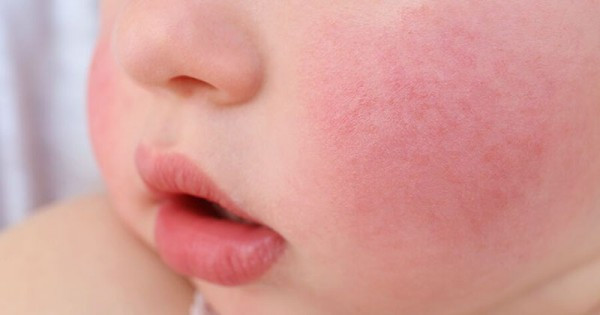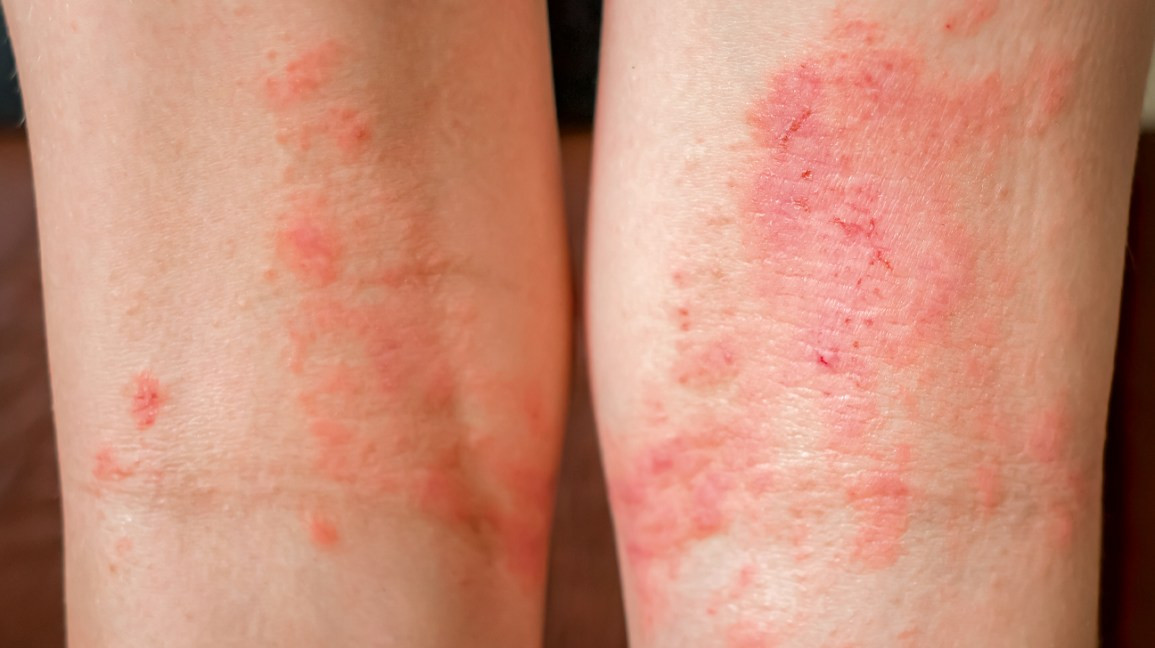Definisi
Dermatitis adalah istilah umum yang digunakan untuk menggambarkan peradangan pada kulit. Kata dermatitis berasal dari kata "derm" yang berarti "kulit" dan "itis" yang berarti "peradangan." Gejala umum dermatitis termasuk kulit kering, ruam kemerahan, dan terasa gatal atau mungkin menyebabkan kulit menjadi melepuh, mengeluarkan cairan, berkerak, dan mengelupas. Ruam dapat bervariasi mulai dari ringan hingga berat dan dapat menyebabkan berbagai masalah, tergantung dari penyebab dasarnya. Dermatitis biasanya tidak menyebabkan masalah yang serius pada tubuh dan bukanlah penyakit yang menular.
Terdapat beberapa jenis dermatitis, antara lain:
-
Dermatitis atopi
Dermatitis atopi merupakan jenis dermatitis yang berhubungan dengan faktor alergi dan dapat diwariskan dalam keluarga. Dermatitis ini biasanya berkembang selama masa bayi, tetapi juga bisa berkembang di masa dewasa. Belum tersedia obat yang dapat menyembuhkan secara total penyakit ini. Penderita dermatitis ini biasanya akan mengalami gejala yang bersifat hilang timbul dan kambuh-kambuhan. Gejala dapat berupa bercak kulit yang tampak kasar, kering, dan gatal.
-
Dermatitis kontak
Dermatitis kontak terjadi ketika suatu zat menyentuh kulit Anda dan menyebabkan timbulnya reaksi pada kulit. Reaksi ini dapat berkembang menjadi ruam yang dirasakan, seperti sensasi terbakar, tersengat, gatal, atau melepuh. Dermatitis kontak terbagi menjadi dermatitis kontak alergi dan dermatitis kontak iritan. Pada dermatitis kontak iritan, suatu zat iritan dari luar secara langsung merusak kulit dan menimbulkan reaksi iritasi. Sementara, pada dermatitis kontak alergi, suatu zat dari luar mungkin tidak secara langsung merusak kulit tetapi akan menyebabkan sistem kekebalan tubuh bereaksi berlebihan.
-
Dermatitis dishidrotik
Pada dermatitis dishidrotik, kulit tidak dapat melindungi dirinya sendiri. Hal ini menyebabkan kulit menjadi gatal, kering, dan seringkali disertai dengan lepuh kecil. Kondisi ini terjadi terutama pada kaki dan tangan, dan juga dapat terjadi pada orang yang berkeringat banyak di area tersebut.
-
Dermatitis seboroik
Dermatitis seboroik pada bayi juga dikenal dengan istilah cradle cap. Dermatitis jenis ini paling sering terjadi pada kulit kepala, meskipun dapat juga terjadi pada wajah, dada, dan sekitar telinga. Kondisi ini sering menyebabkan timbulnya bercak bersisik, perubahan warna pada kulit, dan adanya ketombe. Stres atau kurang tidur dapat memperburuk gejala ini.
- Jenis dermatitis lainnya
- Neurodermatitis. Jenis ini melibatkan bagian kulit yang terasa sangat gatal dan sering dipicu oleh stres atau sesuatu yang dapat mengiritasi kulit.
- Dermatitis numularis. Dermatitis ini biasanya berupa ruam berbentuk oval/bulat seperti koin pada kulit, dan sering terjadi setelah terjadi cedera pada kulit. Numularis berarti "seperti koin."
- Dermatitis statis. Jenis ini melibatkan perubahan kulit karena aliran darah yang buruk. Hal ini dapat menyebabkan terjadinya perubahan warna kulit pada anggota tubuh bagian bawah (khususnya kaki) dan bahkan dapat menyebabkan tekstur kulit menebal.
- Dermatitis neglecta. Dermatitis ini dihasilkan dari kumpulan sebum (minyak), keringat, korneosit (sel kulit), dan bakteri di suatu area kulit yang terlokalisir, membentuk suatu kerak kotoran yang padat dan melekat.
Penyebab
Dermatitis disebabkan oleh kombinasi dari beberapa hal, seperti:
- Sistem kekebalan tubuh. Terkadang sistem kekebalan tubuh Anda dapat bereaksi berlebihan. Jika Anda menderita dermatitis atopi, sistem kekebalan tubuh Anda akan bereaksi terhadap suatu zat yang merupakan hal biasa pada orang lain, tetapi menyebabkan peradangan pada kulit Anda.
- Genetik. Penelitian menunjukkan bahwa jika terdapat orang lain dalam keluarga Anda yang menderita dermatitis, kemungkinan besar Anda juga akan menderitanya. Selain itu, pada penderita dermatitis, ditemukan perubahan pada gen yang mengontrol protein yang membantu tubuh Anda untuk menjaga kesehatan kulit. Kulit Anda tidak dapat tetap terjaga kesehatannya tanpa kadar protein yang normal dalam tubuh.
- Lingkungan. Lingkungan dapat membuat sistem kekebalan tubuh Anda mengubah susunan pelindung pada kulit (skin barrier). Hal ini dapat menyebabkan hilangnya kelembapan dari kulit yang dapat memicu timbulnya dermatitis. Faktor lingkungan yang mungkin berperan termasuk paparan asap rokok dan polusi udara. Kandungan wewangian pada beberapa produk perawatan kulit dan sabun juga mungkin berperan.
- Paparan zat tertentu. Beberapa jenis dermatitis disebabkan oleh paparan terhadap bahan kimia dan zat iritan tertentu.
- Stres. Tingkat stres yang tinggi juga dapat menyebabkan kekambuhan dan memperparah gejala pada beberapa jenis dermatitis.
Faktor Risiko
Beberapa faktor yang dapat meningkatkan risiko Anda menderita dermatitis meliputi:
- Usia. Dermatitis dapat terjadi pada semua usia, tetapi dermatitis atopi lebih sering terjadi pada anak-anak daripada orang dewasa, dan biasanya dimulai pada masa bayi.
- Riwayat alergi dan asma. Orang yang memiliki riwayat dermatitis, alergi, atau asma pada keluarganya atau dirinya sendiri, akan lebih mungkin untuk menderita dermatitis atopi.
- Pekerjaan. Pekerjaan yang membuat Anda bersentuhan dengan logam, zat pelarut, atau bahan pembersih tertentu dapat meningkatkan risiko terhadap dermatitis kontak.
- Kondisi kesehatan tertentu. Kondisi kesehatan yang menempatkan Anda pada peningkatan risiko dermatitis seboroik termasuk gagal jantung kongestif, penyakit Parkinson, dan HIV/AIDS.
Gejala
Gejala dermatitis dapat bervariasi dari ringan hingga berat dan akan terlihat berbeda tergantung pada bagian tubuh mana yang terkena. Gejala akan bervariasi tergantung dari jenis dermatitis yang menyebabkannya. Secara umum, gejala dermatitis mungkin termasuk:
- Timbulnya ruam di kulit
- Kulit kering dan pecah pecah
- Lepuh berisi cairan
- Kulit yang bersisik atau ditutupi koreng
- Kulit yang gatal
- Nyeri pada kulit yang terasa perih atau terbakar
- Pembengkakan pada kulit
- Penebalan atau pengerasan pada kulit
- Perubahan warna pada kulit. Pada kulit yang lebih gelap, ruam dermatitis biasanya akan tampak berwarna abu-abu, ungu, atau lebih gelap dari warna kulit normal. Pada kulit yang lebih terang, ruam dermatitis biasanya akan tampak merah muda atau merah.
- Saat digaruk, ruam bisa mengeluarkan cairan atau berdarah
Diagnosis
Dalam mendiagnosis dermatitis, dokter akan mulai dengan melakukan wawancara dengan Anda. Dokter akan menanyakan gejala-gejala yang Anda alami, seperti bagaimana bentuk ruam yang muncul, di mana saja lokasi munculnya ruam, sudah berapa lama ruam muncul, apakah disertai rasa gatal, dll. Dokter juga akan menanyakan riwayat kesehatan lainnya, seperti riwayat asma, alergi, atau dermatitis pada keluarga atau pada diri Anda sendiri, riwayat dermatitis sebelumnya, riwayat kontak dengan zat-zat tertentu sebelum timbulnya gejala, serta riwayat pengobatan yang sudah diberikan. Kemudian dokter akan melakukan pemeriksaan fisik dengan melihat secara langsung kondisi ruam dan kulit Anda. Biasanya dokter akan dapat mendiagnosis dermatitis berdasarkan hasil wawancara dan pemeriksaan kulit Anda. Namun, jika terdapat keraguan, dokter dapat menyarankan pemeriksaan tambahan berikut:
- Tes darah untuk memeriksa penyebab lain timbulnya ruam yang mungkin tidak terkait dengan dermatitis.
- Biopsi kulit untuk membedakan satu jenis dermatitis dari yang lain. Pada pemeriksaan ini dokter akan mengambil sampel kecil dari kulit yang terkena dan memeriksanya di bawah mikroskop.
- Tes alergi kulit. Jika dokter mencurigai adanya faktor alergi yang berperan terhadap timbulnya gejala, maka mungkin akan dilakukan tes tempel kulit. Pada tes tempel kulit, dokter akan menempatkan sejumlah kecil zat yang berbeda (yang dicurigai menjadi penyebab timbulnya ruam) pada kulit Anda. Setelah beberapa hari, plester akan dilepas, dan dokter akan memeriksa area kulit tersebut, serta menentukan apakah Anda mungkin alergi terhadap zat-zat tertentu.
Tata Laksana
Tatalaksana dermatitis tergantung pada jenis, tingkat keparahan gejala, dan penyebabnya. Beberapa jenis dermatitis akan hilang dengan sendirinya, misalnya, dermatitis kontak akan membaik setelah Anda tidak lagi kontak dengan zat iritan yang menimbulkan ruam. Namun, jika dermatitis Anda tidak membaik secara alami, dokter dapat merekomendasikan:
- Obat untuk mengurangi reaksi alergi dan gatal-gatal, seperti golongan antihistamin, contohnya Diphenhydramine
- Fototerapi, dengan memaparkan area kulit yang terdapat ruam dengan cahaya khusus dalam jumlah yang terkontrol
- Krim oles dengan kandungan steroid, seperti Hidrokortison, untuk meredakan gatal dan peradangan
- Krim atau lotion untuk melembapkan kulit yang kering
Komplikasi
Dermatitis dapat menyebabkan timbulnya ruam yang terasa gatal sehingga menyebabkan kecenderungan untuk menggaruknya. Kebiasaan menggaruk dapat menyebabkan luka terbuka pada kulit, yang mungkin bisa terinfeksi. Infeksi kulit ini dapat menyebar ke kulit sekitar, tetapi biasanya tidak berbahaya. Selain itu, pada orang dengan kulit coklat dan hitam, dermatitis dapat menyebabkan area yang terkena berubah warna menjadi gelap atau terang. Mungkin dibutuhkan berbulan-bulan atau bertahun-tahun untuk mengembalikan ke warna kulit Anda yang normal.
Pencegahan
Beberapa langkah yang dapat Anda lakukan untuk membantu mencegah timbulnya dermatitis, antara lain:
- Hindari paparan zat iritan. Gunakan alat pelindung jika Anda melakukan tugas yang mengharuskan Anda bersentuhan dengan zat iritan atau bahan kimia tertentu.
- Tidak mandi terlalu lama. Batasi mandi Anda hingga 5 sampai 10 menit. Gunakan air hangat, bukan air panas. Mandi terlalu lama dapat membuat kulit menjadi kering.
- Gunakan sabun dengan kandungan yang lembut. Pilih sabun tanpa tambahan zat pewangi. Beberapa jenis sabun dapat terlalu mengeringkan kulit Anda.
- Keringkan diri Anda dengan lembut. Setelah mandi, tepuk lembut kulit Anda hingga kering dengan handuk berbahan lembut.
- Gunakan krim atau salep pelembap kulit. Saat kulit Anda masih lembap (sehabis mandi), segera oleskan krim atau salep pelembap.
- Hindari stres
Kapan Harus ke Dokter?
Konsultasikan diri Anda ke dokter jika mengalami gejala berupa timbulnya ruam yang dirasakan gatal, nyeri, atau seperti terbakar. Dokter dapat membantu mencari penyebab timbulnya gejala, serta memberikan tatalaksana yang tepat.
Mau tahu informasi seputar penyakit lainnya, cek di sini ya!
- dr Anita Larasati Priyono
Dermatitis. (2020). Accessed March 16, 2022, from https://my.clevelandclinic.org/health/articles/4089-dermatitis
Dermatitis. (2021).Accessed March 16, 2022, from https://www.mayoclinic.org/diseases-conditions/dermatitis-eczema/symptoms-causes/syc-20352380
Gardner, Stephanie S. What is Dermatitis?. (2021).Accessed March 16, 2022, from https://www.webmd.com/skin-problems-and-treatments/guide/understanding-dermatitis-basics
Pietro, MaryAnn De. What is Dermatitis?. (2021). Accessed March 16, 2022, from https://www.healthline.com/health/dermatitis











